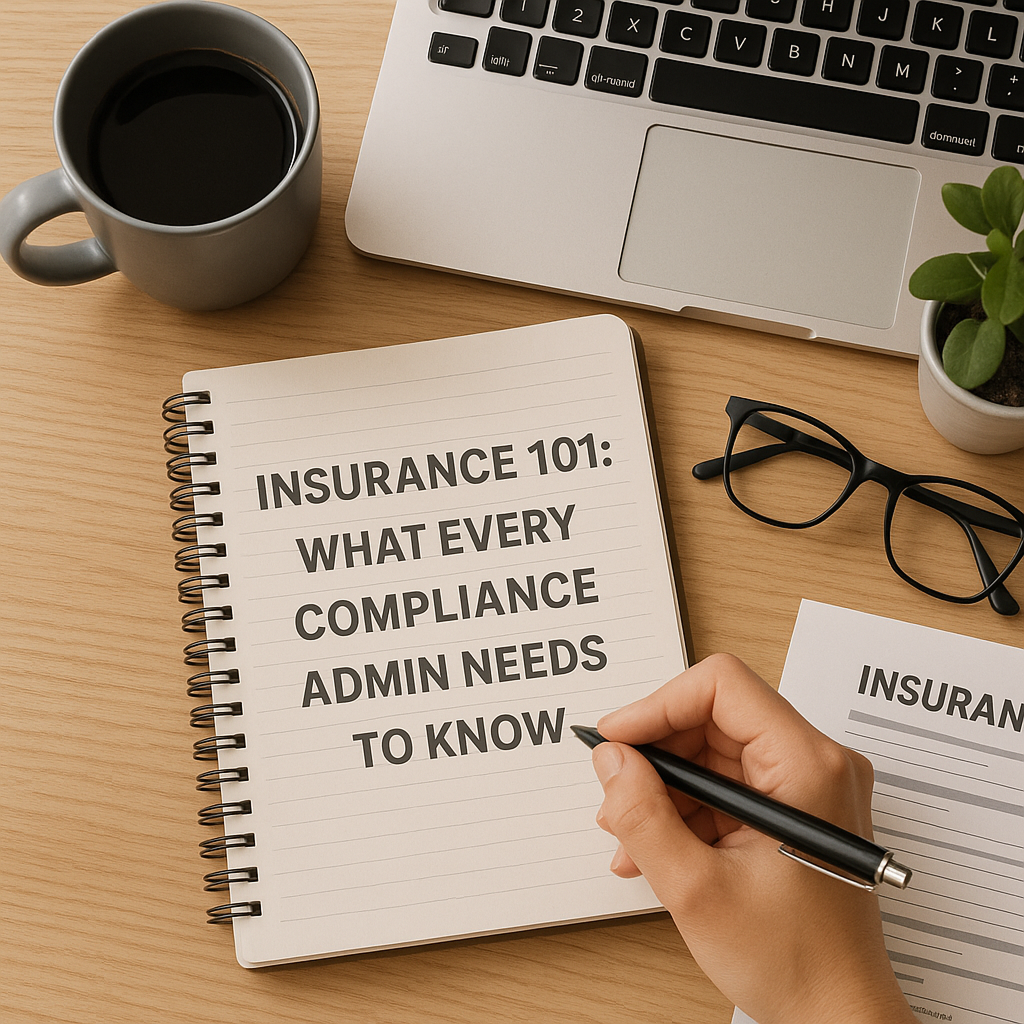
Insurance 101: What Every Compliance Admin Needs to Know
You didn’t set out to be an insurance expert. But if your role touches compliance, contracts, or vendor management, insurance shows up in your inbox — a lot.
The problem? Insurance is packed with jargon, acronyms, and fine print. And yet your responsibility is clear: keep projects moving and protect your company from risk.
Here’s the good news: you don’t need a law degree or an agent’s license. You just need to understand the essentials —enough to spot red flags, ask smart questions, and know when to escalate.
This guide is your crash course. No fluff. No 400-page manuals. Just the building blocks every compliance admin should know to handle COIs (Certificates of Insurance) with confidence.
Compliance isn’t about chasing paper.
It’s about protecting your business from liability. And when it’s done well, compliance isn’t just defense — it becomes part of your company’s growth story.
Here’s how:
● Visible risk = stronger decisions.Leaders move faster when they know coverage is solid.
● Better compliance = smoother partnerships. Vendors trust you when requirements are clear and consistent.
● Strong processes = fewer disputes.Catching gaps early avoids costly claims and project delays.
Learning the basics turns compliance from a stress point into a confidence-builder — for you, for leadership, and for every project you touch.
What a COI Is (and Isn’t)
A Certificate of Insurance (COI) is proof that insurance coverage exists. It lists:
● Who is insured
● What policies they carry
● Policy limits
● Effective and expiration dates
But here’s the catch: a COI is not a guarantee of coverage.
Think of it like a movie trailer. It gives you a preview, but the full story — endorsements, exclusions, obligations— lives in the actual policy. That’s why COIs are useful, but never enough on their own.
Pro Insight: Never assume the COI tells the full truth. If your contract requires endorsements, request the forms.
The Four Core CoveragesYou’ll See Most
These are the insurance building blocks that show up on almost every COI.
1. General Liability (GL)
The backbone of most vendor insurance.Covers third-party injury, property damage, and sometimes personal/advertisinginjury.
Scenario: A contractor accidentally damages your lobby during a repair. GL is the policy that responds.
What to check: Limits match your contract, and operations listed align with the vendor’s work.
2. Workers’ Compensation
Protects employees who get hurt on thejob. Legally required in most states, though exemptions vary.
Scenario: A vendor’s employee slipson-site. Workers’ Comp pays medical costs and lost wages.
What to check: Coverage extends to thestate(s) where work is happening.
3. Auto Liability
Covers vehicles used in vendoroperations.
Scenario: A delivery driver transportingmaterials for your project causes an accident.
What to check: Look for “hired andnon-owned” coverage if vendors use rentals or personal vehicles.
4. Umbrella / ExcessLiability
Provides extra protection above corepolicies.
Scenario: A $2M claim exceeds a vendor’s$1M General Liability policy. Umbrella coverage picks up the rest.
What to check: Which policies theumbrella follows (GL, Auto, Workers’ Comp).
The Endorsements That ReallyMatter
COIs alone aren’t enough. Endorsementsshow how coverage actually applies.
● Additional Insured (AI): Extendsvendor coverage to your business. Without it, you may not be protected.
● Waiver of Subrogation: Preventsthe vendor’s insurer from suing you to recover costs after a claim.
● Primary & Noncontributory:Ensures the vendor’s insurance pays before yours does.
Why this matters: Without theseendorsements, your company could end up footing the bill — even if the vendorwas at fault.
Common Pitfalls (and How toAvoid Them)
These are the traps that trip up evenseasoned admins.
● Expired Dates: Missed expirations= uncovered risk.
○ Fix: Use reminders before renewal deadlines.
● Mismatched Names: If the insuredname doesn’t match the vendor in your contract, coverage might not apply.
○ Fix: Always cross-check COIs againstcontracts.
● Missing Endorsements: A COI mayclaim coverage exists but lack proof.
○ Fix: Always request the endorsement forms.
● One-Size Requirements: Alandscaper and a crane operator don’t need the same limits.
○ Fix: Tier requirements based on vendor risk.
Pro Insight: Create a simple risk matrixthat maps insurance requirements to vendor categories. It keeps your requestsclear and defensible.
How to Build a ReliableProcess
Here’s a repeatable flow you can scale asyour vendor base grows:
- Standardize Requests → Send requirements in writing before work begins.
- Verify COIs Against Contracts → Names, dates, limits, endorsements.
- Track Expirations → Use calendars or software for reminders.
- Escalate Exceptions → Define who approves when vendors fall short.
- Document Everything → Keep an audit-ready trail.
The key? Don’t reinvent the wheel eachtime. Build a framework once, then let automation keep it humming.
From Paperwork to Confidence
Compliance can feel like busywork whenyou’re in the weeds. But step back, and the picture changes:
● Every COI you review preventspotential losses.
● Every endorsement you confirmkeeps liability where it belongs.
● Every renewal you track keepsprojects moving.
You’re not just reviewing paperwork.You’re protecting your company’s growth.
That’s why compliance, done well, isn’t aburden. It’s a driver of fearless growth.
📥 Next Step: Download the Everyday Guide to InsuranceCompliance — your checklist for managing COIs with confidence.
Or keep learning: Read: 10 COI Terms Every ComplianceAdmin Should Know.
